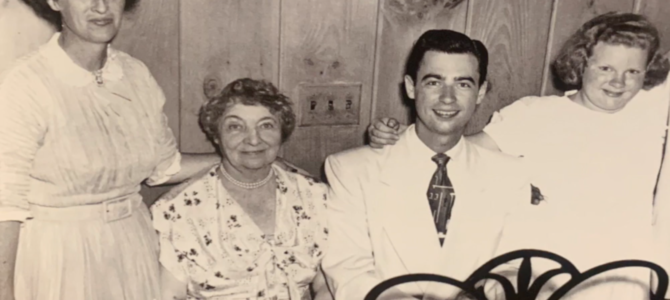
As a songwriter and storyteller, theologian and educator, family man and public figure, Fred Rogers should be known for much more than wearing a red cardigan. He earned degrees in music composition (writing more than 200 songs during his life) and in theology (ordained by the Presbyterian Church into children’s television ministry), then studied for years under leading child psychologist Margaret McFarland.
With two films about his life released in the last two years alone, most Americans have some impression of who Rogers was: a public television pioneer who played with puppets, a saint who preached kindness, or a simpleton jibed by Eddie Murphy on “Saturday Night Live.” Last week, Tom Hanks received his first Oscar nomination in 19 years for portraying Rogers, ensuring the recent biopic “A Beautiful Day in the Neighborhood” will be examined deeper.
Beyond his drive for excellence, one overarching truth defines his legacy: how Rogers was fully present for each person he met. A chance encounter on the street resulted in an hours-long talk. Meeting a clergyman at a funeral led to a close friendship. Every viewer who reached out received a personal reply that seemed to notice and affirm them like no one else did.
Although Rogers died in 2003 at age 74 after contracting stomach cancer, his principles, innovative television programs, and countless stories live on. Admittedly it’s a bit ironic to list products by and about Fred Rogers, who was famously anti-consumerist. All the same, these 15 resources can help parents and educators who carry on his life’s work of listening to and caring for children.
Essential Rogers Reading
- “The Good Neighbor” by Maxwell King (2018, 320 pages)
Pittsburgh journalist and philanthropist Maxwell King, also founding director of the Fred Rogers Center, spent eight years researching and writing this definitive biography. Although he is close to the Rogers family, “The Good Neighbor” is no hagiography: readers learn how the isolation Rogers felt as a shy, pudgy kid stuck with him into adulthood, his demands on creative staff were great, and the inside jokes he and his wife Joanne shared could be off-color.
A serious biography with 20 pages of source notes, “The Good Neighbor” gives the big picture on his life and work. He was born into privilege, son of Pennsylvania industry titans. When his grandmother promised to buy young Fred a piano, she didn’t know the 10-year-old would pick out a Steinway Grand that cost $60,000 in today’s dollars. On that prized piano, he wrote nearly all those 200 songs. From Rogers’ script discussions with McFarland, to his show’s differences with “Sesame Street,” this tome compiles small moments with big insights throughout.
- “Dear Mister Rogers, Does It Ever Rain In Your Neighborhood?” by Fred Rogers (1996, 208 pages)
This small paperback has a wealth of wisdom, containing dozens of children’s and parents’ letters along with Fred’s responses. Kids as young as three ask about “bad guys” on TV shows, if Fred ever uses the bathroom (since it’s not seen in his “house”), and the loss of a beloved pet.
In one chapter, an association of Oregon educators planned a regional symposium on the question “What is most worth knowing?,” posing the inquiry to Rogers. “What I believe is most worth knowing is that every human being has value,” replied Fred. “This is the basis of all healthy relationships; it cannot be ‘taught’ but it can be ‘caught.’”
- “The Simple Faith of Mister Rogers” by Amy Hollingsworth (2005, 224 pages)
Tom Junod, the subject of the new biopic starring Hanks, was not the only journalist changed through his interactions with Rogers. “Your neighbor is anyone you happen to be with at the moment,” said Rogers, echoing ideas from the Christian gospel. “Then you have a choice. You can either advocate for that person or you can be that person’s accuser.”
The ordained minister rarely spoke about his faith, making an exception with CBN host Amy Hollingsworth. In the last decade of his life, the two struck up a friendship. Still a bestseller 14 years later, her book includes never-before-seen letters and revelations on his religious beliefs.
- “Mister Rogers’ Playtime” by Fred Rogers (2001, 128 pages)
One of the last books Rogers published before his death wasn’t a glossy autobiography or thick work of abstract ideas. It was a hands-on activity book for parents to use with their children, containing dozens of easy-to-do crafts and activities peppered with advice and philosophy in each chapter. It reflects how Rogers shunned attention on himself in favor of serving families in practical ways.
His Shows And Songs
- “Mister Rogers’ Neighborhood” (1968-2001, 886 episodes)
PBS and Fred Rogers Productions have done a great service by making his unedited original programs widely available. A basic Amazon Prime account includes access to more than 100 half-hour video episodes, opening his unique world of exploring emotions and children’s questions through puppets, songs, visiting Pittsburgh-area sites, and a calming routine. With an added PBS subscription, families can watch hundreds more episodes.
- “It’s Such A Good Feeling: The Best of Mister Rogers” (2019 compilation, 23 songs)
Jazz enthusiasts in Pittsburgh, and soon nationwide audiences, came to recognize “Mister Rogers’ Neighborhood” as one of TV’s best forums of improvisational music. Rogers’ simple melodies gave his lifelong music director Johnny Costa plenty of leeway to experiment, as he did every day with a live band performing throughout the “Neighborhood” show. Jazz legend Wynton Marsalis appeared on the show, as did renowned cellist Yo-Yo Ma, who became a close friend.
- “A Beautiful Day in the Neighborhood: The Poetry of Mister Rogers” (2019, 144 pages)
Rogers’ songs are deceptively simple, using words kids can grasp while conveying big ideas to ponder. “Did you know that it’s alright to wonder? / You can ask a lot of questions / About the world and your place in it / There are all kinds of wonderful things.” This hardcover book presents his song lyrics alongside bright, imaginative illustrations, perfect for parents and kids to sing and enjoy together.
- “Daniel Tiger’s Neighborhood” (2012-2020, 105 episodes so far)
https://www.youtube.com/watch?v=_TCg2bZ4DqA
“Blue’s Clues” creator Angela Santomero grew up watching Rogers’ show, and led the charge when the opportunity came to produce a new animated version of the neighborhood. It’s a wonder how well it captures the original series—gentle pacing, characters talking to camera, theming a half-hour around one idea—while adding brighter colors and more music. Recently renewed for a fifth season, production of “Daniel Tiger’s Neighborhood” is ongoing.
Live Experiences And Podcasts
- Heinz History Center in Pittsburgh, Pennsylvania
If you want to see the Neighborhood of Make Believe up-close, you can thanks to the devoted curators at the Heinz History Center. The museum’s fourth floor includes the largest collection of items from Rogers’ show on public view, including significant parts of his TV “home,” colorful puppet sets, and exhibits that bring to life his musical brand of educational storytelling.
- “Finding Fred” Podcast
To capitalize on current interest in Fred Rogers, several leading producers have created podcasts to explore his ideas and their relevance to today. iHeartRadio has perhaps the best, as “Finding Fred” host Carvell Wallace speaks with figures who personally knew Rogers and those impacted by him.
- Fred Rogers Center in Latrobe, Pennsylvania
While the creatives at Fred Rogers Productions continue to produce PBS programs, they partner closely with experts in psychology and child development at Fred Rogers Center based at St. Vincent College in his hometown of Latrobe. Their archive contains more than 18,000 items from Rogers’ life and work, in addition to a public exhibit and ongoing educational programs to further advance his ideas.
Films On His Life and Work
- “Won’t You Be My Neighbor?”(2018, documentary, 94 minutes)
If you’ve seen someone crying over an in-flight movie in the past year, there’s a good chance they were watching director Morgan Neville’s fast-paced, award-winning documentary. Splicing archive Rogers clips—including his famous U.S. Senate testimony—with moving interviews of his wife Joanne, family members, and show staff, it follows several threads of creativity, faith, and philosophy to get at the heart of his life’s mission.
- “Mister Rogers: It’s You I Like” (2018, documentary, 60 minutes)
Oscar winner Michael Keaton got his start in the Pittsburgh arts scene as a behind-the-scenes stagehand on “Mister Rogers’ Neighborhood.” He hosts this PBS retrospective that looks closer at the music and notable guests of the neighborhood — packing not as much emotional oomph as Neville’s film, though including several original stories from those who knew Rogers best.
- “Mister Rogers and Me” (2012, documentary, 71 minutes)
In interviews with Rogers and books about him, it’s curious how the interviewer almost always becomes a character in the story due to Fred’s effect on people. So it is with this low-budget documentary, which follows a road trip to sites important in Rogers’s life. The host visits offbeat figures who knew the public TV icon, with more about his spirituality than you’d expect.
- “A Beautiful Day in the Neighborhood” (2019, dramatic film, 109 minutes)
Interviewed in Pittsburgh, Joanne Rogers and Bill Isler of The Fred Rogers Company answer:
"You both are famously protective of Fred Rogers' legacy and his characters
Why did you have confidence in this script and these filmmakers to say: 'Let's go for it'?"#ABeautifulDayMovie pic.twitter.com/Ryic122ima— Josh M Shepherd (@JoshMShep) November 27, 2019
Biopics have a certain formula, a narrative from trial to triumph that can easily become cliché. This film goes a much more creative route—inventive in one sense, although puzzling to some in how much side characters and incidents are fictionalized. Undoubtedly one of the best actors of our time, Hanks exudes Rogers without impersonating him through prosthetics or mimicry.
Ten years in the making since its first script, several moments in the movie perfectly capture Rogers’ personality and make it worthwhile. Hopefully, this film will be the first step in a long journey of viewers discovering the real-life educator, puppeteer, and neighbor.









